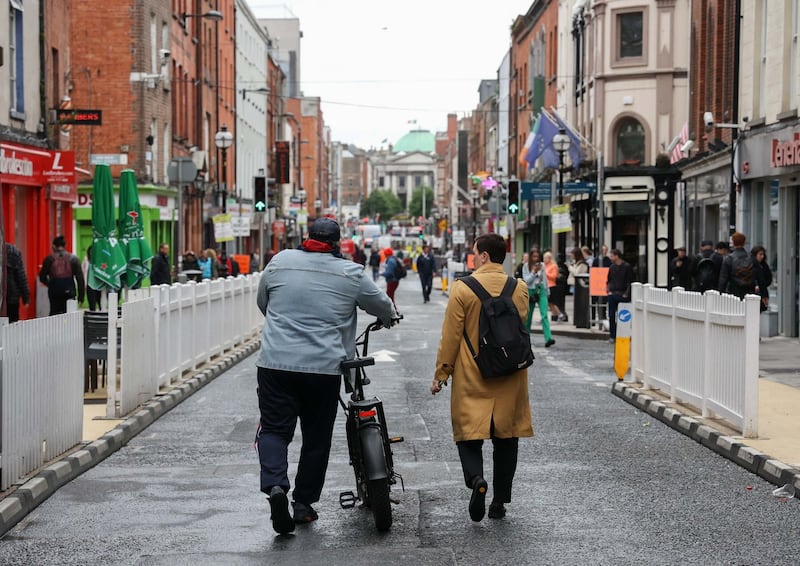The car dominance of Dublin’s Capel Street has come to an end as it becomes the latest, and longest, traffic-free street in the city.
With a 400m pedestrian and cycle area stretching from Parnell Street and Ryder’s Row at its northern end, to Strand Street in the south, Capel Street’s traffic exclusion zone exceeds both Henry Street and Grafton Street in length.
All car parking has been removed from the street and through traffic has been banned. Deliveries will be permitted from 6am-11am daily, after which bollards will prevent entry.
The Luas line crosses the street at Abbey Street and traffic will be allowed to at this point but only in an east to west direction.
The pedestrian zone will end at Strand Street, with the area between Panti Bar and Jack Nealon’s pub to the quays remaining open to traffic. This will facilitate the new pedestrian plaza on nearby Liffey Street, which the council said required the use of this part of Capel Street for an exit route for traffic. It will also allow apartment residents on Strand Street to drive to the quays.

Unlike Grafton Street and Henry Street, Capel Street will remain open to cyclists, but footpaths will be retained and pedestrians “will have priority” in the roadway, according to the council.
The council last summer implemented trial pedestrianisation measures on Capel Street banning traffic from the street from 6.30pm to 11.30pm at weekends. More than 7,000 submissions were made to a subsequent consultation process, the largest number of submissions the council has ever received to a public consultation. Almost 80 per cent were in favour of pedestrianising Capel Street on a permanent basis with almost 90 per cent seeking some traffic-free measures.
The council held a short consultation last month on its final plan and 1,776 submissions were received – 91 per cent in favour of the new traffic-free proposals.
Opening the traffic-free zone on Friday, Lord Mayor Alison Gilliland acknowledged there remained some businesses who were opposed to the measures.
“Change is always difficult. This is traditionally a road that has a lot of traffic passing by and yes some people do park and use the shops,” she said.
“But if people are walking past your shop instead of driving past your shop there is a greater likelihood they will actually go into your shop and purchase.”
Capel Street tailor Louis Copeland said he had been supportive of the evening pedestrianisation but was "totally against" the day-time closure of the road to cars. "This is the city centre equivalent of trying to pedestrianise the M50," he said.
Many Capel Street businesses dealt in bulky goods that required to be transferred directly to cars he said. “Nobody is going to take a chainsaw on the Luas. It’s going to put people off coming to the street if they can’t park outside for collections.”
Ms Gilliland said the council would continue to work with businesses to try to address their issues. “We want a collaborative process that will make this work for everybody.”
Some residents of the neighbouring markets area, immediately to the west of Capel Street, said traffic had been extremely heavy on Friday morning.
"All the cars that should be on Capel Street have been pushed on top of us," Linda Fitzpatrick of St Michans House on Greek Street said.
"People couldn't get to work this morning, or get kids to school because they couldn't get their cars out of the flats," she said. "We've got nothing from [Dublin City Council] for this. Nobody asked us if we wanted this."

The council’s head of traffic Brendan O’Brien, said information leaflets had been distributed throughout the area.
“We had 17 weekends of trials, we had three public consultations with substantial responses on it. We did leaflet drops throughout the entire area from Church Street over, so we feel there was plenty of consultation and we have had signage up for several weeks all around the area.”
Capel Street could derive even greater benefits from pedestrianisation than Grafton Street or Henry Street, which lacked pubs and restaurants.
“Unlike Henry Street and Grafton street that maybe close after six o’clock, this street has two different audiences. It has got the retail but also night-time activity.”
Some concerns had been raised about potential anti-social behaviour, particularly in relation to street drinking at night. Ms Gilliland said the council would be working closely with the Garda to ensure this did not become a problem.
“Drinking is only allowed in outdoor areas that are part of a bar or restaurant, and we would ask bar owners and managers to be good and to manage that appropriately.”





